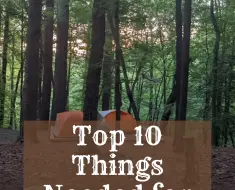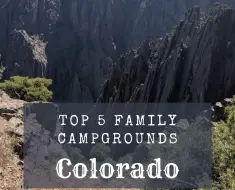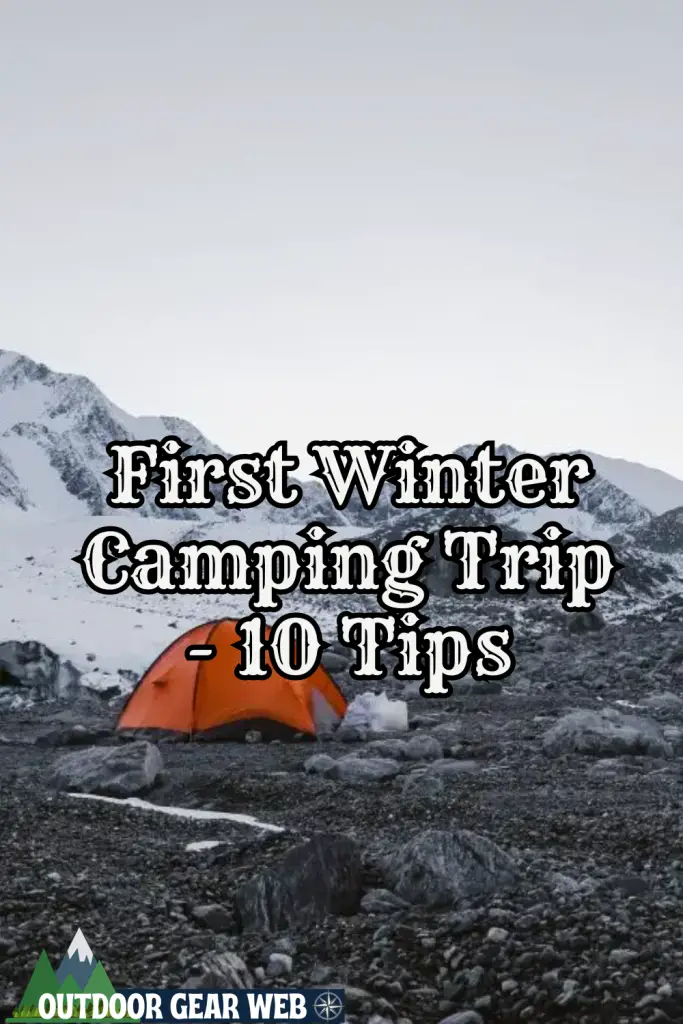
We all want to be comfortable when winter camping and for some of us it means heading to a VRBO cabin in a ski town. For others, it implies loading up the sleds and heading out on day trips. For the bolder, it implies getting a pack and pulling in every one of the necessities to a distant area. If you want to see immaculate snow-shrouded mountains, stars early in the clear winter sky, or sunrise glistening on the frost it is important to be ready for your winter camping trip. Setting up camp in winter can be daunting for some but it is an extraordinary way of relishing those serene minutes and settings only found in winter. Regardless of how you winter camp, the following 10 tips are sure to help on your first winter camping trip.
Getting ready for your first winter camping trip is simpler than you might suspect. You can thrive in winter camping and not freeze while doing it! Many winter campers succeeded in freezing environments long before the invention of our modern technology. So you don’t have to worry about turning into the Donner party just yet! At the same time, you don’t really have to burn through every last dollar at big sporting goods stores for winter gear. Of course, this list will help you be prepared so you don’t freeze.
Want to save money on your winter camping gear? Find out how!
A Quick Starting Note
Before we get started there are a few basics that we want to cover. Always ensure that your gear is rated for the appropriate temperatures and situations you may find yourself in. Additionally, make sure that you are doing your first trip in a heavily trafficked area. Remember to test all of your gear in a safer environment first so that you know how to use each piece effectively. Using these basic tips will help if something does go wrong so you will be found quickly. Build up to those long winter trips! As always, practice, practice, practice and consider the outdoor risks!
First Winter Camping Trip Tips!
Whew! Now that we have covered that basic information, let’s dive right into the list to help on your first winter camping trip!
1. Select the right campsite
If this is your first trip camping in the wintertime it may be beneficial to select designated campgrounds. This will help to ensure that there are locations where you can quickly escape if the weather turns so severe that you need support. These will likely be near populated areas as well.
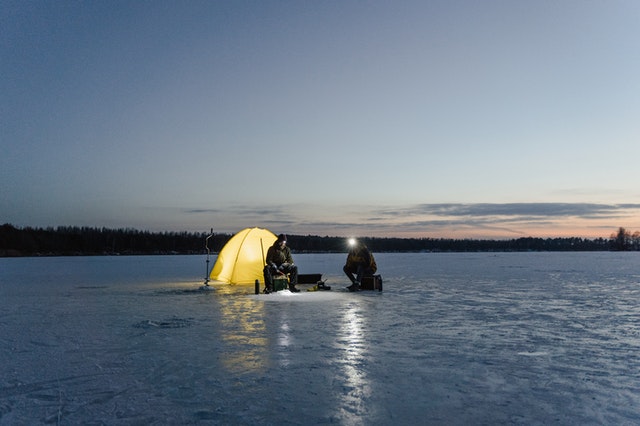
Selecting your campsite in the backcountry is more critical. Trust your instincts in site location and use the information from that weather report to determine which way you may end up facing strong winds. If you are still building instincts then we have help for selecting your campsite! You don’t want to set up your tent where snow and wind can blow right in. Additionally, make sure to look up. Sturdy branches with lots of snow on them can still break. So while you think you may be gaining extra cover you may actually have a widowmaker fall right on your tent. In any case, survey the surroundings and make sure that you have protection from the elements.
2. Pack down the snow
Now that you have selected your site it is time to prep it for placing your tent and cooking area. So start stamping around and pack down your campground. If you have skis or snowshoes, that implies slogging around hard until all the snow is stuffed. If all you have are the boots you walk into camp with then it is going to take a little more time! Basically, you want to spend time compacting as much of the snow in your camp as you can. There are a few reasons for this. The first is that in deeper snow it could be hiding bushes that have created voids that could cause injury later. You also may set your tent in a place where the snow is thinner but hide sticks that could damage your tent.
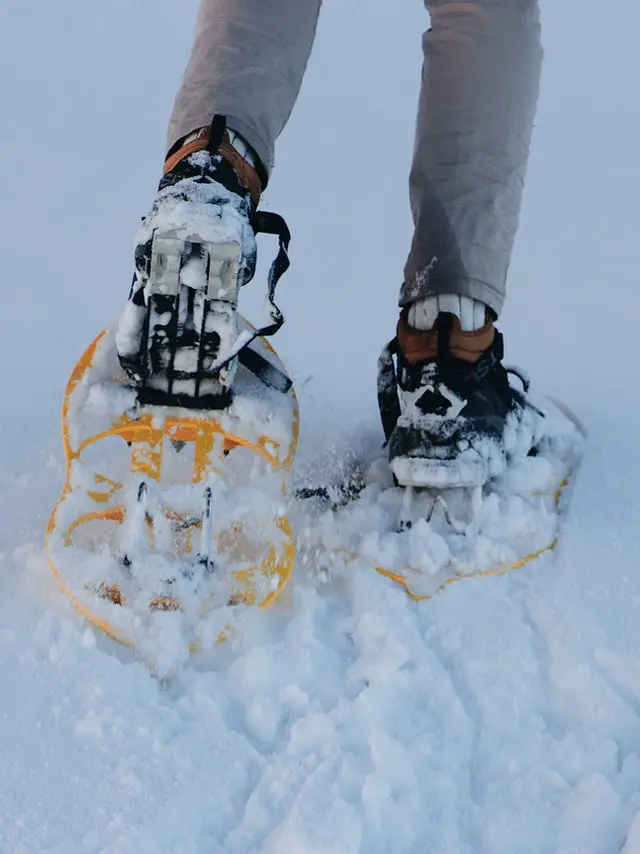
A little site prep can go a long way to ensuring that you do not injure yourself day or night! So take your time upfront and make sure that you have your camp laid out and have all the snow packed down. If you are in a designated campground then it is likely you will not need to use this tip. However, you should still walk the site and make sure that there are no branches or debris that could damage your gear.
3. It’s time to layer up for your first winter camping trip!
The lynchpin to your first winter camping trip is a tight base layer to trap body heat. Having the three basic layers in place can mean the difference between life and death. Adding long underwear to your winter wardrobe can work incredibly but there are many different options now. You will want to select the appropriate attire so that you can have your own body thermostat throughout the day. Trust us even though it is cold outside, if you layer right you are going to get warm! Make sure that you have a sturdy base layer that wicks water away. A mid-layer that provides insulation like in the walls of your house. Finally, add a protective shell around both to keep the snow and water out.
How to choose your basic layers
Most importantly in the winter, you should keep away from cotton. Cotton is cool in the summer, but it’s horrible at wicking dampness. When this material is wet it can actually cool you faster even with other layers. So stick to merino wools and synthetic blends that are specifically designed to handle winter conditions.
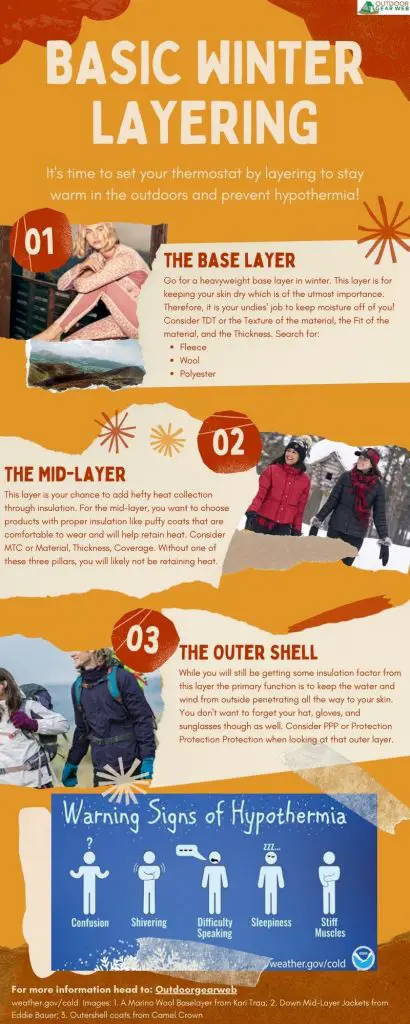
4. Additional protective shell
Having an outer layer that protects against wind and moisture is important it should also have another function. Inevitably while you are on your first winter camping trip you are going to want to build a fire. This fire may be for cooking, warmth, or spirit. Aside from frostbite or hypothermia, nothing will stop a camping trip faster than lighting yourself on fire! So ensure that your external layer of clothing is not only wind and waterproof but also fireproof. This will help protect you in the event that there is a wayward ember blown from your fire.
Fleece is one of those materials that are truly outstanding. It can keep you warm and prevent some injury in most cases. There are other heat-proof materials that are incredible for this as well. While down coats are great for insulating you against the cold they may actually be worse for fire protection.
Need fleece for your winter camping? Look here for Fleece-Lined Hiking Pants – 5 Best Women’s
5. Pick the right sleeping bag
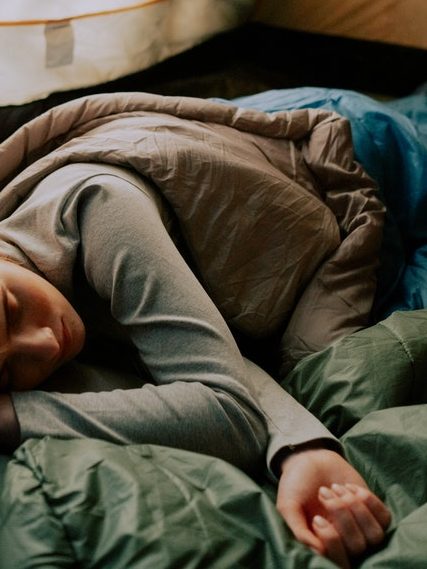
Do you like to go camping in the summertime? If so, then you likely already have a sleeping bag. Before you go shell out a lot of money for a bag specific to winter check and see what the rating is on your current sleeping bag. You may be surprised to find that the bag you have may be capable for the conditions you will be in. This means that you should also check the predicted weather conditions during your trip. Even in winter, there can be warmer nights. Make sure when you take the weather into account that you prepare for the unexpected. I always assume the weather can be about 20 degrees below predicted when purchasing my gear. This helps add a buffer in case something happens.
You don’t have to rush out and buy an expensive bag though! Instead, if your current bag has some cold weather capability you can extend this by purchasing a sleeping bag liner. This could broaden the temperature rating of your hiking bed by 10 to 15 degrees. If estimated lows are way out of your sleeping bag’s reach, you’ll need to put resources into a 0-degree or lower pack. It is also okay to start your first winter camping trip on warmer winter days and as you get better improve your gear! As said before practice makes perfect!
6. Insulation under your sleeping bag
Your sleeping bag isn’t the only thing you should have for nighttime. You should not just consider having a sleeping pad under your bag because it is a necessity. While a sleeping pad helps to make your night more comfortable it serves another purpose. They keep you off the frozen ground or packed snow. Sleeping right on the ground drains away your body heat quicker than the air outside. It is similar to placing a car battery on the ground. Your heat will be quickly sapped and you will no longer have the energy to function.
This is another area that can get quite expensive. There are some costly inflatable sleeping pads out there. However, the important thing to remember is that you are trying to get yourself up off the ground. So consider having two inexpensive thinner layers under your sleeping bag instead of one extremely expensive one. You want to pick something you can bear the cost but also do the work. It is okay to be creative if your pack can handle the extra weight. On the off chance you did not plan correctly, you can always place clothing between your bag and the sleeping pad. This will add an extra insulating layer as well.
7. Moisture is the enemy on your first winter camping trip
We covered some gear requirements but all of that is for not if it gets wet. The old first winter camping trip adage is to stay dry. If that is not an old adage I am making it one right now! The reason that we sweat in the summer is to provide evaporative cooling to our bodies. Just because it is cold outside does not mean that the laws of thermodynamics stop. In fact, water conducts heat better compared to air, so wet garments will rapidly bring down your internal heat level. If you find that your clothing thermostat or sleeping arrangements are causing you to sweat then you need to start removing layers. Go slowly and strip off layers to restrict sweat.
For longer camping trips you will want to consider a vapor boundary liner for your sleeping bag. You might not realize it until the first morning of your winter camping trip but you can sweat while you sleep. Moisture can start to build up and can freeze inside the upper layer of your camping bed. This will occur where the warm air meets the freezing air, and over the long haul, your sleeping bag will freeze solid. The vapor boundary can help to prevent this to some degree. You can also do some preventative work during the day by turning the bag inside out and setting it in the sun. Just remember not to do this if it is snowing!
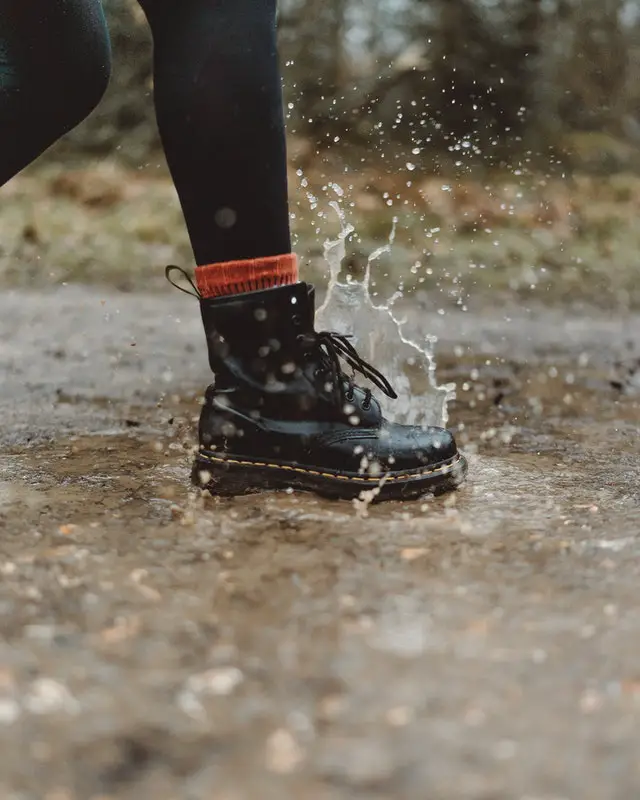
This doesn’t stop at just your clothing or sleeping bag though. If you have wet feet then you have frozen feet. It is rare that wet boots will dry quickly. So you need to make sure that you have the right waterproofed foot attire for being outdoors. Leave the sneakers at home. Waterproof boots and gaiters (alongside snowshoes) are an absolute necessity while walking through deeper snow.
While on a backpacking trip, you will be concerned with the weight it is important to pack extra clothing. The added weight may be worth it to ensure your survival. Extra clothes come in handy when your first set is wet. Remember one is none!
Find our picks for the best women’s hiking boots that will protect your feet.
8. Stay hydrated not frozen
Many of us think of dehydration as a summertime worry. It is just as important to stay hydrated when exerting yourself in the wintertime. So you want to make sure that you have ample water on hand. With frigid nights upon you, the water bottles you have bought may freeze. You can prevent waking up to frozen water though. Think about how a pond freezes. We are able to go ice skating on the top and the fish continue to live below the surface. This is because the surface freezes first. If you have a large water tank that you have brought with you then store it upside down overnight. This may prevent the nozzle from getting frozen. If it is very cold you may not be able to avoid it.
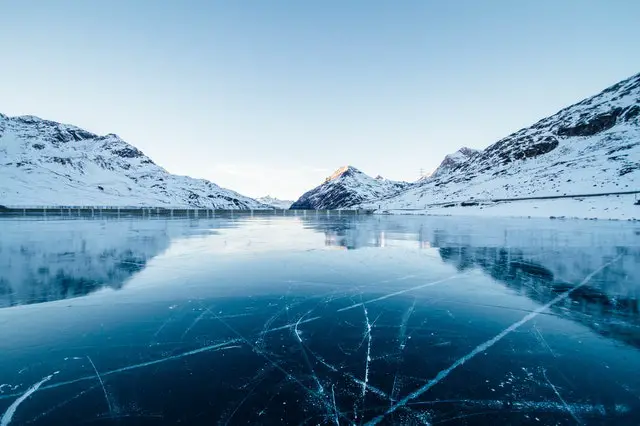
However, if you have a smaller water bottle or camelback you could always place it in your tent near where you are sleeping. Taking these steps can ensure that you have water to spare during the day!
9. The first winter camping trip morning
You survived the night! It stayed nice and toasty throughout the snowfall that occurred while you slept. You peek out through the zipper of your tent and the start realization hits you. There is no coffee shop nearby to get that added jolt of energy you so desperately need. Not to worry if you planned correctly. It is time to relight that fire or start the camp stove. Get a nice pot of boiling water going and get ready for some camp coffee.

There are many different options from instant to bringing along a French press. Heck, there is even the old cowboy method of swinging your hot coffee in a circle to settle the ground. For me, it is easy to bring along a little lap of luxury and carry a French press and grounds. Because honestly, there is nothing better on a winter morning than enjoying that cup of coffee. If you aren’t a coffee drinker then make sure to bring along your favorite warm beverage to kick your day off right!
10. A lighter note about winter bathroom use!
Well, now you are warmed up from the coffee and are well-hydrated. That is great news, but eventually, nature is going to come calling. Do not wait when it comes to going to the bathroom. Your body will consume important calories to warm anything in your bladder. Some like to keep an additional jug in the ten. Just don’t mix it with the water you stored in your tent! This ensures that you don’t need to wander into the cold for midnight relief. Being cold can make us have the urge more often, and we as a whole are poorly designed to leave the warmth of our bed in the middle of the night.
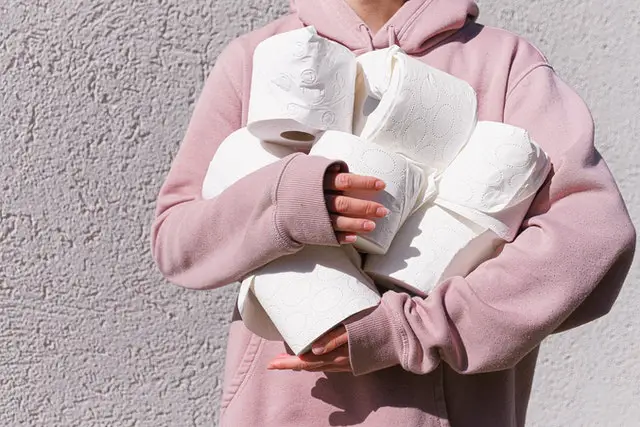
It is not just urination that is a concern though in the winter. Camping in other times of year we have access to comfortable leaves for wiping. However, in winter your natural toilet paper is rare. Before you run to use a pinecone…OUCH…consider another method. Bidets are popular in parts of the world and while chilly you could use a handful of snow to wash. It isn’t the best but it could do if you didn’t do forward planning and bring actual toilet paper with you. For gosh sake, just pack the toilet paper and some extra grocery bags. You are not going to be able to dig a cathole so you should plan to pack out anything you have to deposit. No one wants to find a pile of toilet paper comes springtime!
First Winter Camping Trip Tips
So there you have it! The ten things that you should consider when going on your first winter camping trip. If you incorporate each of these ten things into your planning then you will be all set! Remember that the most important thing while winter camping is staying warm and dry. If you cannot manage these two things then you are going to have a bad trip. A little planning upfront will make your overall experience that much better! So take your time and remember to practice
What do you think? While these are the top ten that should always be considered there are lots more! What are the things you wish you knew on your first winter camping trip? We would like to hear about them in the comments, on our Facebook, or on Reddit!







